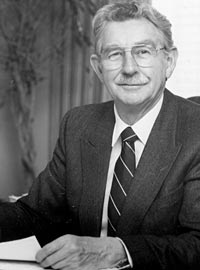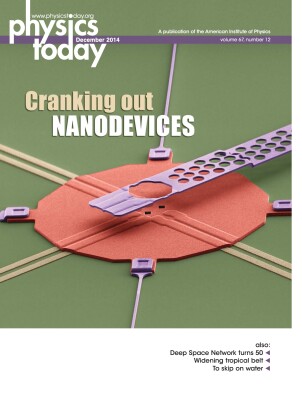Warren Keith Sinclair
DOI: 10.1063/PT.3.2630
Warren Keith Sinclair celebrated his 90th birthday amid family shortly before his death on 14 May 2014 in Escondido, California. We personally have lost a dear friend, and the radiation science community has lost a most respected colleague. His career, which spanned three continents and almost 50 years, can be divided into three phases: medical physics, radiobiology, and radiation protection. He excelled in all.

Warren Keith Sinclair
COURTESY OF NCRP

A native of New Zealand, born in Dunedin on 9 March 1924, Warren attended the University of Otago and received a BSc in 1944 and an MSc in physics in 1945. In 1944 he wrote a government report about uranium in New Zealand rocks, before the element’s potential for nuclear weaponry was widely known. His interest in the use of radiation in medicine began when he was appointed hospital physicist at Dunedin Hospital, the first such position in New Zealand. Given the paucity of educational opportunity at home, he was advised by Ernest Marsden to obtain a doctorate in medical physics with W. V. Mayneord in London. The 1947 voyage to England held a surprise that would enhance his whole life—he met Joy, his future wife.
The timing of Warren’s arrival in England was propitious; radioisotopes were becoming available from the UK Atomic Energy Research Establishment and Oak Ridge National Laboratory, and clinicians were initiating plans for their use. Mayneord’s medical physics group at the Royal Cancer Hospital was ideal for Warren’s professional development. Physics colleagues and academic clinicians at the hospital, where Warren was appointed an assistant physicist, along with numerous visitors to Mayneord’s department, added to the fertile environment. Warren was instrumental in expanding the clinical uses of radioisotopes and in developing techniques for their measurement and handling. Those included brachytherapy, or internal radiotherapy, with tantalum-182 in wires and the treatment of bladder cancer with balloons filled with radioactive solutions. His work attracted medical scientists eager to learn about the use of radioactive sources for therapy.
While completing requirements to earn a PhD in physics at the University of London in 1953, Warren was appointed a lecturer in radiological physics and biophysics. He also took night courses in physiology, biochemistry, zoology, and botany. His zest for knowledge and the breadth of his interests helped make him an exemplary interdisciplinary investigator and science administrator.
In 1954 Warren accepted the invitation of Gilbert Fletcher to head the physics group at the MD Anderson Hospital for Cancer Research and to be a professor in physics at the University of Texas Postgraduate School of Medicine in Houston. Fletcher’s radiotherapy department had recently installed a cobalt-60 gamma-ray unit and a betatron that emitted high-energy x rays. If the effectiveness of the two beams and similar ones in other centers were to be compared, standardized and accurate calibration techniques would be essential.
Warren measured the relative effects of the two sources on various biological targets and thus determined their relative biological effects (RBE) with considerably more precision than had previously been done. His RBE studies heightened his interest in cell responses to radiation in vitro. Although he had fine collaborators at Anderson, Warren was anxious to have his own laboratory. So in 1960 he became senior biophysicist at Argonne National Laboratory (ANL), and in 1964, a professor in the department of radiology at the University of Chicago.
In his studies at ANL, Warren examined the effects of radiation on cells exposed in different stages of the cell cycle. The cyclic variations observed in vitro to ionizing and UV radiation and drugs were a significant addition to our understanding of radiation effects. In 1970 he became director of ANL’s division of biological and medical research, and four years later he was associate laboratory director for biomedical and environmental research.
Concerned over the professional development of physicists in medicine, Warren, John Laughlin, and Gail Adams helped found the American Association of Physicists in Medicine in 1958.
In 1977 Warren was elected president of the National Council on Radiation Protection and Measurements (NCRP) and had the difficult task of succeeding its founder, Lauriston Taylor. Again the timing was propitious, as the NCRP’s influence was waning. Warren succeeded in restoring its influence, expanding the council to include experts in relevant fields, and publishing reports that were welcomed by both scientists and government agencies. For example, after the Three Mile Island reactor accident in 1979, controversy arose about the planned venting of the remaining krypton-85 into the atmosphere. At the request of Pennsylvania governor Dick Thornburgh, within three weeks the NCRP delivered a report on the safety of venting.
Warren played key roles in the NCRP, the International Commission on Radiological Protection, and the United Nations Scientific Committee on the Effects of Atomic Radiation in developing radiation protection standards. He also made important contributions to the support of radiation science in his positions as president of the Radiation Research Society and chairman of the National Research Council’s Board on Radiation Effects Research.
Warren was reserved in composure but had a twinkling mien. He stood by his convictions with unflinching integrity. He will be remembered as much for his trustworthy character as for his solid contributions to radiation research and policy.
More about the Authors
R. J. Michael Fry. Indianapolis, Indiana.
S. James Adelstein. Boston, Massachusetts .
